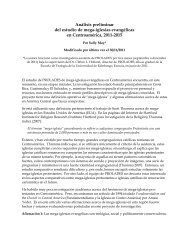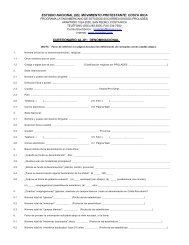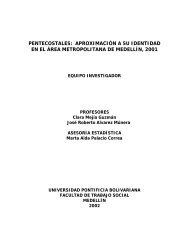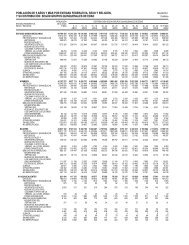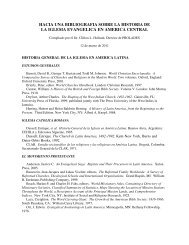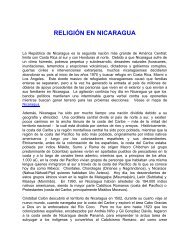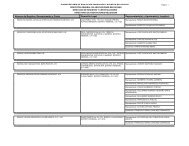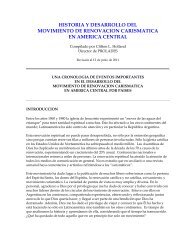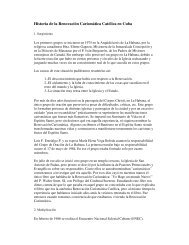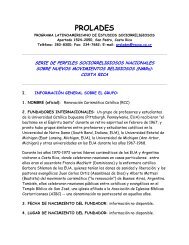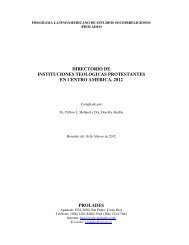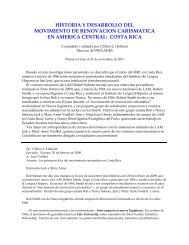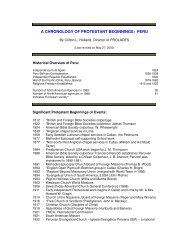belize, 1980 - Prolades.com
belize, 1980 - Prolades.com
belize, 1980 - Prolades.com
You also want an ePaper? Increase the reach of your titles
YUMPU automatically turns print PDFs into web optimized ePapers that Google loves.
and Mopan Maya in the southern lowlands. There, numerous Kekchí churches have been<br />
established, and some form part of the newly-organized Kekchí and Mayan Churches of Belize<br />
(Pentecostal). The entire New Testament is available in Kekchí, along with a hymnal, several Old<br />
Testament books, and a dozen Gospel tracts.<br />
The Yucatan Maya, numbering about 540,000, live in the Mexican states of Yucatan,<br />
Campeche and Quintana Roo, and in the districts of Orange Walk and Corozal in Belize. In 1847,<br />
the Maya in the Yucatan Peninsula revolted against the Spanish settlers (known as the Caste War,<br />
1847-1904), which resulted in thousands of Maya and Mestizos fleeing south over the border into<br />
British Honduras. By 1861, the population of the Colony had grown to 25,635 (<strong>com</strong>pared to 8,235 in<br />
1841), with one-quarter of the people living in the northern district and most of these were Yucatan<br />
refugees. Whereas today an estimated 45,000 Yucatan Maya speakers are associated with<br />
evangelical churches in Mexico, there are only about 120 evangelical believers in Belize. Four small<br />
congregations have been established since 1958 in Corozal District by the National Presbyterian<br />
Church of Mexico, no doubt following up on some of their members who migrated into Belize.<br />
Rapid acculturation has taken place among the Yucatan Maya, and many are now fluent in Spanish;<br />
however, the older adults still prefer their native language. Parts of the New Testament were<br />
translated into Yucatan Maya in 1844, but the entire New Testament was not available until 1961<br />
(revised in 1977).<br />
3.4 BLACK CARIB - GARIFUNA (7.6% according to the <strong>1980</strong> Census)<br />
The British Colonial Administration used the term Black Carib to refer to the Garifuna or<br />
Garinagu (Garifuna refers to both the people and language of the Garinagu), and to distinguish<br />
them from Yellow or Red Carib, who are Amerindian groups. Racially, the Black Carib are<br />
descendants of runaway African slaves who intermarried with the Red Carib Amerindians in the<br />
West Indies during the 18th century. The British deported about 5,000 Black Carib from the islands<br />
of Dominica and St. Vincent in 1797, and relocated them to the Bay Islands of the Bay of Honduras.<br />
From there the Black Carib gradually dispersed and established settlements along the northern<br />
coast of Honduras, south to Pearl Lagoon in Nicaragua, and north to the Livingston area of eastern<br />
Guatemala and into British Honduras in 1823 (celebrated as Settlement Day). Most Black Carib in<br />
Belize today make their living from fishing and subsistence farming near Punta Gorda and Stann<br />
Creek on the south coast, although some Black Carib have be<strong>com</strong>e teachers and businessmen,<br />
and a few are doctors and lawyers. An estimated 2,000 Black Carib live on Guatemala’s eastern<br />
coast and about 10,600 in the southern coastal lowlands of Belize.<br />
The Black Carib have maintained their separate identity despite the fact that physically they<br />
differ little from the Creoles. While retaining their own languages (men and women historically<br />
speaking separate languages), many Black Carib also speak English, and a growing number are<br />
learning some Spanish due to trading contacts with the Kekchí and Mopan Maya who live nearby.<br />
Generally, Black Carib do not marry outside their own ethnic group.<br />
Most Black Carib are animists and few are practicing Christians, either Catholics or<br />
Protestants, although many are considered to be at least nominally Christian. However, their<br />
religious life is dominated by spirit worship, black magic and ceremonial dances of mixed African<br />
and Indian origin. Few Black Carib actively attend Protestant churches, even though some<br />
evangelical witness has existed among them since the 1830s, mainly by Methodists, Baptists and<br />
Anglicans have had schools and mission stations in their settlements. Other Protestant groups have<br />
worked among the Black Carib more recently, notably the Nazarenes since the 1960s. Portions of<br />
the Bible were first translated into Garifuna and "Waike" (Arawak) by a Baptist missionary,<br />
11



